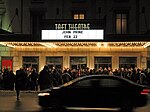Literary Club of Cincinnati

The Literary Club of Cincinnati is located at 500 East Fourth Street, across from Lytle Park in downtown Cincinnati, Ohio. The club occupies a two-story Greek Revival house which was built in 1820, on the site of the home of William Sargent, secretary of the Northwest Territory. The Club was founded in 1849; its membership is limited to 100 men.The club was founded by woman's rights activist and abolitionist John Celivergos Zachos, Stanley Matthews (judge), Ainsworth Rand Spofford librarian of congress and 9 others. One year later President Rutherford B. Hayes became a member. Other prominent members included President William Howard Taft and notable club guests Ralph Waldo Emerson, Booker T. Washington, Mark Twain, Charles Dickens, Oscar Wilde and Robert Frost.Today, the clubhouse is a contributing property to the Lytle Park Historic District, a historic district that is listed on the National Register of Historic Places.Among the important roles of the Literary Club is that of historian, who delivers an annual paper on a topic of his choosing that deals with the history of the club. The long-time historian was John A. Diehl, who was elected a member of the club in 1965. After his more than two decades in the post, the club published a book of his papers as historian. The current historian is Robert Vitz.
Excerpt from the Wikipedia article Literary Club of Cincinnati (License: CC BY-SA 3.0, Authors, Images).Literary Club of Cincinnati
East 4th Street, Cincinnati Central Business District
Geographical coordinates (GPS) Address External links Nearby Places Show on map
Geographical coordinates (GPS)
| Latitude | Longitude |
|---|---|
| N 39.101388888889 ° | E -84.504666666667 ° |
Address
Literary Club of Cincinnati
East 4th Street
45202 Cincinnati, Central Business District
Ohio, United States
Open on Google Maps








